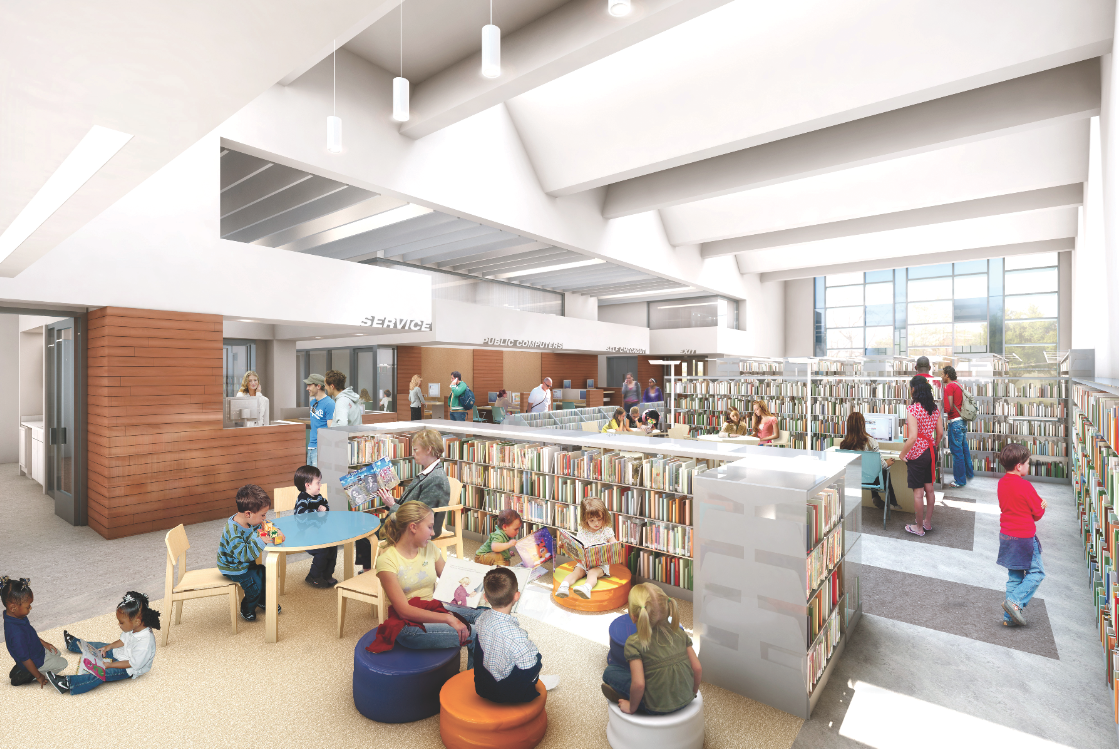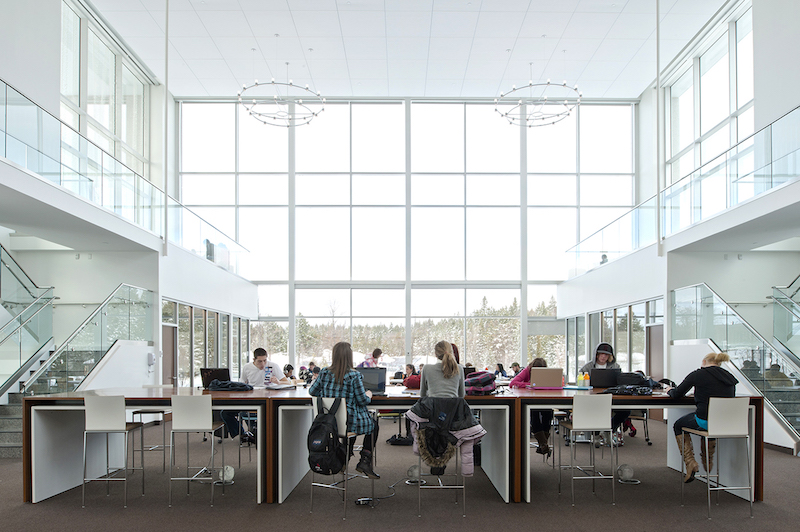Situated on a tiny, quarter-acre lot along bustling University Avenue, Berkeley, Calif.’s, new West Branch library may not be large in stature, but it’s one of the most significant library projects of the year.
Due to open in August, the 9,500-sf facility will join a handful of libraries across the country that are net-zero energy performers. And, if all goes as planned, the facility will achieve net-positive energy performance—supplying power back to the city’s electrical grid—and have a carbon-neutral footprint.
The project’s Building Team, led by Harley Ellis Devereaux’s GreenWorks Studio (www.harleyellisdevereaux.com), is targeting LEED Platinum. The $5.5 million library is one of the first projects to take part in the California Public Utility Commission’s ZNE Energy Pilot Program, supported by the Pacific Gas and Electric Co.
Michael Bulander, LEED AP BD+C, Associate with Harley Ellis Devereaux, says the PG&E partnership was critical to achieving NZE performance on the West Branch project. The utility subsidized early computer modeling work, including computational fluid dynamics analysis of ventilation schemes and a solar axis study for the rooftop solar installations.
The latter was especially tricky, says Bulander, due to the project’s tight urban site. “The starting point for the entire design was actually the building’s roof,” he says. “Because taller buildings surround the tiny site—including a three-story hotel next door—the team had to determine the optimal roof configuration for accommodating as many PV and solar thermal panels as possible, and for minimizing shading from the other buildings.”
Projected Energy Performance
Renewable energy generation
Photovoltaic panels 15.4 kBtu/sf/year
Solar thermal panels 2.0 kBtu/sf/year
Total power generation 17.4 kBtu/sf/year
Building electrical load
Lighting 3.8 kBtu/sf/year
Heating 3.5 kBtu/sf/year
Cooling (heat pumps) 2.2 kBtu/sf/year
Plug load 6.3 kBtu/sf/year
Hot water 0.9 kBtu/sf/year
Ventilation fans 0.7 kBtu/sf/year
Total power load 17.4 kBtu/sf/year
Net energy consumption 0.0 kBtu/sf/year
The rooftop solar panels also had to compete for space with three rows of skylights that were instrumental to the building’s daylighting scheme. And, of course, the roof configuration had to meet the programmatic requirements for the library.
“It was a real balancing act,” says Gerard Lee, AIA, LEED AP, Associate and Project Manager with Harley Ellis Devereaux. “We had to find the sweet spot between what the building wanted to be from a program standpoint and what it should be from an energy-performance standpoint.”
Through modeling, the design team determined that the optimal design consisted of a compact, rectangular roof, 24 feet high. The solar panels are oriented horizontally, stacked three high at a 20-degree angle to maximize solar collection throughout the year. Four PV arrays are interspersed between three rows of skylights. A total of 120 panels will generate 75,050 kWh/year with a final system efficiency of 93.8%. The 16 solar thermal panels are located in two arrays at the northeast corner of the roof.
“The design takes into consideration the skylight locations and heights,” says Lee. “The PV panels are angled and located to avoid casting shadows on the skylights, and the same can be said for the skylights.”
The team modeled the design to maximize the number of solar panels that could be installed on the compact roof. The photovoltaic and solar thermal panels were situated so as not to interfere with the three rows of skylights.
Once the roof design scheme was established and the team could accurately calculate the amount of solar energy that would be harvested, they went about designing the building to minimize the energy use intensity to match the renewable energy supply.
“Our EUI is very low in relation to other projects—just 17 kBtu/sf/year,” says Bulander. For comparison, the average office building has a EUI of 193; hospitals can exceed 500.
Passive design requires careful modeling, detailing
Passive design strategies like natural ventilation, radiant heating/cooling, and daylighting helped meet the aggressive energy goals. Prevailing winds off the Bay made natural ventilation a logical approach, but the site proved problematic yet again. Because the building is located in a high-traffic area next to a stoplight, placing operable windows in the main façade was not feasible. “Trucks often wait at the red light in front of the building,” says Bulander. “We needed to block that out.”
To minimize energy consumption in the building, the design scheme utilizes daylighting through a series of skylights and a large glass curtain wall on the main façade. Where possible, the team minimized the amount of electrical lighting in the building, such as in the back office areas. When the library closes for the day, the entire facility will essentially go dark to reduce energy use.
With the help of CFD modeling, the design team devised a clever natural ventilation scheme that uses negative pressure to pull in fresh air at the rear of the building and then circulate it through the interior spaces.
“We’re essentially using the steady wind that is blowing over the top of the front façade to create a negative pressure that pulls the air through the building,” says Lee. A series of louvers and ventilation fans at the roof level will exhaust the warm air as needed, and radiant flooring will provide supplemental heating and cooling. A building automation system will monitor and control the entire process, ensuring that the interior climate remains comfortable for the staff and patrons.
“We’re trying to make the facility as automated and foolproof as possible,” says Lee. He says the BAS will allow staff to override certain settings—such as closing an operable window on an unusually windy day—but it will automatically revert to its programmed settings at the end of the day. “For the most part, it’s a very intelligent building that needs very little interference from the librarians and staffers.”
As with any net-zero building project, plug loads are a major concern for the Building Team. Library patrons will notice a dearth of outlets in the new facility. This is meant to minimize the number of people who plug in their energy-gobbling laptops, smart phones, and tablets. The library will offer free computer and Internet access for visitors, but in lieu of desktops that are plugged in all day, users will be able to check out fully charged laptops. A charging station will allow the staff to track and control the amount of energy being consumed by the computers.
Lee and Bulander are fully confident that the library staff and patrons will embrace the resource conservation efforts. A building performance dashboard will greet all visitors at the main entrance, providing a real-time snapshot of the building’s energy production and energy/water consumption.
“We’re taking advantage of the ‘Prius effect,’” says Bulander. “When you see a display showing how much energy and water you’re using, you feel more involved in trying to minimize it. It becomes a game.”
The building’s natural ventilation scheme involves pulling in outdoor air from the rear of the building and circulating it throughout the interior spaces. A series of louvers and fans at the roof level will exhaust the air as needed.
PROJECT SUMMARY
Berkeley Public Library – West Branch
Berkeley, Calif.
BUILDING TEAM
Client: City of Berkeley, Calif.
Architect, sustainability consultant, commissioning agent: Harley Ellis Devereaux, GreenWorks Studio
General contractor: West Bay Builders
MEP engineer: Harley Ellis Devereaux
Structural engineer: Tipping Mar
Civil engineer: Moran Engineering
Landscape architect: John Northmore Roberts and Associates
Cost estimator: Cumming Corp.
GENERAL INFORMATION
Size: 9,500 sf
Cost: $5.5 million (est.)
Completion: August 2013
Related Stories
Life of an Architect Podcast | May 2, 2023
Life of an Architect Podcast Ep. 124: Show Me the Money
I get asked a lot about how much money an architect makes. Without understanding a few parameters, that’s like trying to buy a car by the pound. I spend a fair amount of my time discussing the architectural marketplace, where we can find value, what’s the going salary rate based on skill set and experience, and how badly we need this spot or that spot filled.
Hotel Facilities | May 2, 2023
U.S. hotel construction up 9% in the first quarter of 2023, led by Marriott and Hilton
In the latest United States Construction Pipeline Trend Report from Lodging Econometrics (LE), analysts report that construction pipeline projects in the U.S. continue to increase, standing at 5,545 projects/658,207 rooms at the close of Q1 2023. Up 9% by both projects and rooms year-over-year (YOY); project totals at Q1 ‘23 are just 338 projects, or 5.7%, behind the all-time high of 5,883 projects recorded in Q2 2008.
Architects | May 1, 2023
HOK names Eli Hoisington and Susan Klumpp Williams as Co-CEOs
HOK has appointed Eli Hoisington, AIA, LEED AP, and Susan Klumpp Williams, AIA, LEED AP, as its new co-chief executive officers, succeeding Bill Hellmuth, FAIA, LEED AP, who passed away on April 6, shortly after his scheduled retirement.
Multifamily Housing | May 1, 2023
A prefab multifamily housing project will deliver 200 new apartments near downtown Denver
In Denver, Mortenson, a Colorado-based builder, developer, and engineering services provider, along with joint venture partner Pinnacle Partners, has broken ground on Revival on Platte, a multifamily housing project. The 234,156-sf development will feature 200 studio, one-bedroom, and two-bedroom apartments on eight floors, with two levels of parking.
Mass Timber | May 1, 2023
SOM designs mass timber climate solutions center on Governors Island, anchored by Stony Brook University
Governors Island in New York Harbor will be home to a new climate-solutions center called The New York Climate Exchange. Designed by Skidmore, Owings & Merrill (SOM), The Exchange will develop and deploy solutions to the global climate crisis while also acting as a regional hub for the green economy. New York’s Stony Brook University will serve as the center’s anchor institution.
Market Data | May 1, 2023
AEC firm proposal activity rebounds in the first quarter of 2023: PSMJ report
Proposal activity for architecture, engineering and construction (A/E/C) firms increased significantly in the 1st Quarter of 2023, according to PSMJ’s Quarterly Market Forecast (QMF) survey. The predictive measure of the industry’s health rebounded to a net plus/minus index (NPMI) of 32.8 in the first three months of the year.
Sustainability | May 1, 2023
Increased focus on sustainability is good for business and attracting employees
A recent study, 2023 State of Design & Make by software developer Autodesk, contains some interesting takeaways for the design and construction industry. Respondents to a survey of industry leaders from the architecture, engineering, construction, product design, manufacturing, and entertainment spheres strongly support the idea that improving their organization’s sustainability practices is good for business.
Codes and Standards | May 1, 2023
Hurricane Ian aftermath expected to prompt building code reform in Florida
Hurricane Ian struck the Southwest Florida coastline last fall with winds exceeding 150 mph, flooding cities, and devastating structures across the state. A construction risk management expert believes the projected economic damage, as high as $75 billion, will prompt the state to beef up building codes and reform land use rules.
| Apr 28, 2023
$1 billion mixed-use multifamily development will add 1,200 units to South Florida market
A giant $1 billion residential project, The District in Davie, will bring 1.6 million sf of new Class A residential apartments to the hot South Florida market. Located near Ft. Lauderdale and greater Miami, the development will include 36,000 sf of restaurants and retail space. The development will also provide 1.1 million sf of access controlled onsite parking with 2,650 parking spaces.
Architects | Apr 27, 2023
Blind Ambition: Insights from a blind architect on universal design
Blind architect Chris Downey shares his message to designers that universal design goes much further than simply meeting a code to make everything accessible.




















